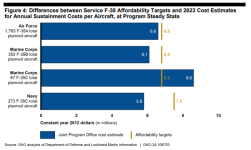LM unable to deliver war capable block4/TR3. F-35 Program has to be reorganised.
“I’m getting tired of over-promising and under-delivering,” F-35 program head Air Force Lt. Gen. Mike Schmidt said.

breakingdefense.com
WASHINGTON — For years, delays and cost growth on a suite of F-35 upgrades known as
Block 4 has vexed the Joint Strike Fighter program. Bowing to those problems, officials today revealed they may have to “reimagine,” or completely restructure, the entire upgrade plan.
While no final decisions about the way forward on Block 4 has been made, the same challenges also led program officials to announce that any F-35 jets delivered for another year will receive only an early version of the Technology Refresh 3 (TR-3) software that will not include full combat capability.
Both pieces of news came from F-35 program lead Air Force Lt. Gen. Mike Schmidt, during today’s testimony in front of the House Armed Services tactical air and land forces subcommittee. In written remarks, Schmidt explained that an independent review last year determined that “numerous Block 4 capabilities will not deliver until the 2030s” — years later than a
recent estimate offered by congressional auditors — prompting the program to “reimagine” the Block 4 upgrade altogether.
The newly-envisioned Block 4 would instead focus on delivering “‘must-have” content,” Schmidt wrote, which will include an undefined “subset” of 88 capabilities originally approved as part of the Block 4 plan. “Reimagined Block 4 must consist of ‘what industry can actually deliver’ across the Future Years Defense Program (FYDP),” Schmidt wrote, and will likely consist of traits like enhanced electronic warfare and communications capabilities.
The issue has not been decided, Schmidt wrote, and requires buy-in from all members of the F-35 enterprise. Additionally, Schmidt wrote the F-35 program has established new “capability decision points” (CDP) to ensure certain hardware and software can go out to the fleet, emphasizing that program officials are “confident” in Block 4 deliveries associated with those CDPs.
The F-35 program will lay out the new Block 4 approach in “a combat relevant timeframe with yes a subset of capabilities of the Block 4 program, but those which give us the most bang for the buck,” Schmidt said in response to a question from subcommittee Chairman Rep. Rob Wittman, R-Va.
“And honestly, sir, I’m getting tired of over-promising and under-delivering and I need to change that narrative,” he added.
“I want it to reflect reality. I want them to understand what can you do realistically,” Wittman said of the Block 4 plan in a scrum with reporters after the hearing, pointing to the use of tools like digital design in a “reimagined” approach.
“Black 4 ought to be an experience that can not only get us further in the software design and upgrades for F-35, but it also should inform what we’re doing in digital design and digital twin development” on next-gen fighters, Wittman said.
TR-3 Deliveries
To harness many Block 4 upgrades, the F-35 needs a set of hardware and software known as Technology Refresh 3 (TR-3). That too has been
delayed numerous times as plane maker Lockheed Martin struggles with validating the TR-3 software, prompting the Pentagon to
halt deliveries of newly-built jets.
Lockheed has maintained in a most recent revised projection that it expects to start delivering jets outfitted with TR-3 in the third quarter of this year, or sometime between July and September. Today, Schmidt said the earliest those deliveries could commence would likely be in the July timeframe, though an independent review suggested instead that August or September could be more likely.
But there’s a catch — those jets would only be delivered with “truncated” software, or an interim version of TR-3 that does not include all capabilities, including ones critical for combat. It’s a plan officials have
discussed for months, and Schmidt confirmed today for the first time that the program’s partners have all agreed on the criteria for the plan. “And if we meet those requirements we will truncate,” he said after the hearing.
Through the new plan, the TR-3 software would be released in two separate drops, with the first being the truncated version, Schmidt wrote. A fully combat-capable software load would then be delivered in a second release that Schmidt said could come over a year later.
Numerous problems have led to the TR-3 delay ranging from lab limitations to optimistic projections, Schmidt highlighted. Specifically, Schmidt said in written remarks that TR-3 suffers from issues with “hardware design maturity,” which “manifests in low manufacturing yields of parts necessary for aircraft production.” Additionally, the hardware problem has also led officials to “us[e] software to overcome hardware design maturity challenges.”
As a result, DoD
stopped accepting new F-35s last summer, and the Pentagon has been withholding payments on sequestered planes, Bloomberg has
previously reported. Asked whether that arrangement would continue under the truncation plan, Schmidt said “We will negotiate the terms and conditions of the truncation.”
After the hearing, Wittman downplayed the impact of not having the complete software upgrade, saying there is “utility” in delivering fighters without full combat capability. He reasoned that the jets can offer training opportunities and that current TR-2 training jets “can easily be combat coded and upgraded.
“Then they’re gonna have to really squeeze to make sure they can do as much as they can to compress to 12 to 16 months to get them combat capable,” he continued. “And that’s just a normal part of the process. So it’s not unusual to TR-3, it’s a normal part of getting these software upgrades into an aircraft and then go[ing] through testing it and getting it combat coded.”
Wittman’s bigger concern, he said, is just getting the software deliverable in the first place.
“I’m confident once they get this delivered, that the effort of getting it combat-coded is not going to be that difficult. The difficulty is getting the software delivered and performing,” he said.
Citing the company’s quiet period ahead of an earnings call scheduled for April 23, a Lockheed spokesperson said the company could not provide further information for this report.













